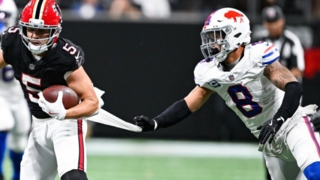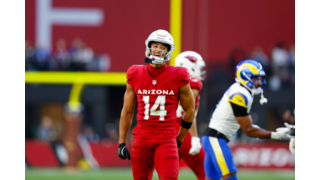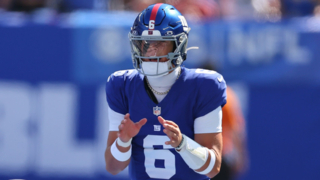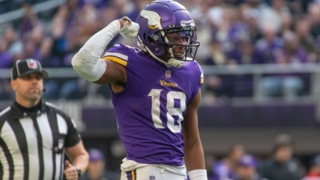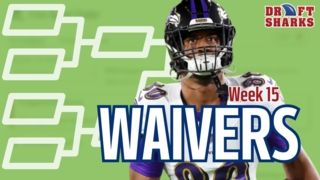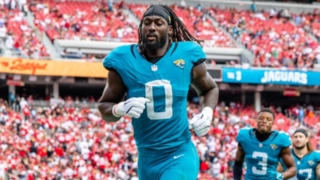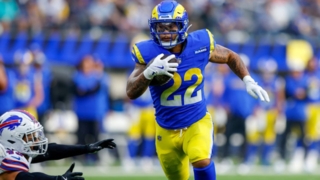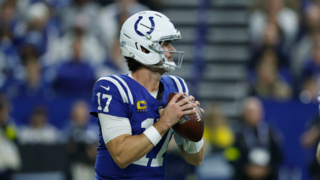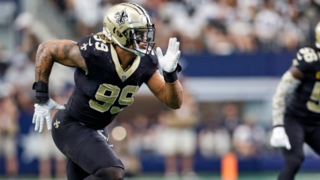NFC Team-by-Team Backfield Breakdowns

Workhorses are almost extinct.
Only Derrick Henry and Dalvin Cook reached 300 carries last year. Only Josh Jacobs joined them north of 250. And just 10 backs league wide reached 200 rushing attempts.
Of those 10 guys, only 5 also caught 40+ passes, with David Montgomery and Ezekiel Elliott the only 2 at 50+.
Almost every backfield is split to some degree. That makes it especially important to sort through the situations and determine what we can reasonably expect.
So let’s dig into each of the NFC backfields and determine how the touches and fantasy points will be divvied. The “top fantasy target” for each team below is the best value at ADP, not necessarily the highest-ranked player in that backfield.
Coming tomorrow: AFC Backfield Breakdowns
Arizona Cardinals
Top fantasy target: Chase Edmonds
Others in the mix: James Conner, Jonathan Ward, Eno Benjamin
You could just as easily argue Conner as the “top target” here, given Edmonds’ 3-round lead over his new teammate in ADP. Both sit outside the top 24, though, so they’re only primary plans at the position if you opt to wait to address RB. And their positional ADPs (RB26 for Edmonds, RB36 for Conner) match up almost exactly with our rankings for the players in either PPR or half-PPR formats.
Edmonds looks like the better bet to lead the Arizona backfield in touches. He garnered just 20.25% of Arizona carries last year, vs. 49.9% for Kenyan Drake (who missed a game). That share should grow at least a little bit this season, though. A year after applying the transition tag to keep Drake at about $8.5 million in salary, the Cards waited a month into free agency to sign Conner for just $1.175 million.
Conner has lost 3+ games to injuries each of the past 3 seasons and watched both his receptions per game and yards per catch decline each of the past 2 years. He has reportedly already sat out at least portions of camp practices, though we’ve seen no report of a specific injury.
Arizona RBs coach James Saxon said in June that Conner is “capable of doing whatever you ask him to do.” When asked specifically whether Conner can catch the ball, however, he said, “Oh yeah, but I don’t think you want to ask an elephant to ride in a sailboat.”
So it sounds like the Cards plan for Conner to be the hard-charging, inside-running complement to Edmonds as the space player. Edmonds ranked 4th among Cardinals in targets last year and 7th among all RBs in receptions. He could see further growth in that area, if Conner falls short of the 5.4% target share that Drake drew in 2020.
Ward reportedly filled in when Conner sat out 1st-team reps in team drills recently. Benjamin has yet to generate much buzz since arriving as a 7th-round pick last year. We’ll see how Arizona fills out the depth chart and what either shows in the preseason.
Overall, though, this doesn’t look like a high-upside situation for RB fantasy points. Drake did manage 10 rushing scores last year (vs. just 1 for Edmonds). The upside on Conner is that he does just take over what Drake got last year. But QB Kyler Murray also accounted for 50% of the team’s ground TDs. That Arizona team also ranked 4th in the league in rushing TDs vs. just 13th in total points. So we wouldn’t be surprised to see the rushing-TD pie shrink in 2021.
Atlanta Falcons
Top fantasy target: Mike Davis
Others in the mix: Qadree Ollison, Cordarrelle Patterson, Javian Hawkins, Caleb Huntley
Davis gets the top spot here by virtue of being the only Atlanta RB who has really done anything in the NFL so far. His 412 career carries lead everyone else in this backfield by more than 200. And the only guy with more targets or catches is Patterson, who has spent most of his 8-year career as a wideout.
Davis almost has to be the top bet for fantasy bets out of this current backfield group, and he has reportedly been the 1st guy up in workouts so far. New HC Arthur Smith said in the offseason, though, that he planned to use a committee. It’ll be tough to know until the season starts exactly what that touch distribution might look like.
Ollison has reportedly run 2nd among Falcons RBs in early practices. Of course, it’s worth noting that the team will be putting on pads for the 1st time on the same day this article publishes. So there’s plenty left to develop here. That could also include Atlanta adding to the backfield -- a possibility Smith acknowledged back in spring.
Patterson has seen some time at RB before, but Atlanta is the 1st team to list him at that position. He averaged a career-high 4.0 carries per game last season, a number that seems bound to grow with his new designation. Can he turn into the Falcons’ top receiving bet out of the backfield? We’ll see. The top-shelf return man at least sports the highest ceiling in that area among current Atlanta RBs.
Hawkins arrives off an exciting career at Louisville and sports flashy speed. Huntley topped 200 carries in both of his 2 full seasons at Ball State. Both rookies went undrafted, though, and will need to prove they deserve roster spots -- in the NFL as well as in fantasy leagues.
I’ve stated my case against Davis (at cost) and would personally rank him lower than where we have him. He’s certainly the best bet for fantasy points in the Atlanta backfield right now. But this just might be a backfield worth avoiding altogether.
Carolina Panthers
Top fantasy target: Christian McCaffrey
Others in the mix: Chuba Hubbard, Rodney Smith, Reggie Bonnafon
There’s nothing sneaky about this backfield. The last time we saw a full season of McCaffrey, he was playing under a different coaching staff. But last year’s version averaged 19.7 carries and 5.7 receptions across his 3 appearances. That’s 315 rushes and 91 catches. And McCaffrey left 2 of those 3 games a little early.
Gone is last year’s fill-in, Mike Davis. But the Panthers allowed him to walk for a modest 2-year contract. Then they picked Hubbard in Round 4, as the 8th RB off the board. That Day 3 draft capital guarantees him nothing, of course. And losing some spring practice time to a “soft-tissue injury” couldn’t have helped. Still, the 2019 campaign that saw him rack up a nation-leading 2,094 rushing yards positions Hubbard as the ceiling play behind McCaffrey.
Smith and Bonnafon are likely competing for a roster spot. Fantasy-draft ADP assumed Bonnafon would be the McCaffrey handcuff last summer. He wound up just 4th among Panthers RBs in both carries and targets, though. Smith checked in 3rd in each category and heads into Year 2 after arriving from Minnesota as an undrafted free agent. He compiled 879 carries and 65 receptions across 6 years with the Golden Gophers (2 redshirts) and brings size: 6’4, 225 pounds. But Smith is just an average athlete for the position.
We’re betting on Hubbard as the #2 back here but will keep an eye on the situation through camp and preseason. Mike Davis showed us all last year what’s possible if McCaffrey goes down.
Chicago Bears
Top fantasy target: David Montgomery
Others in the mix: Tarik Cohen, Damien Williams, Khalil Herbert
Cohen has opened training camp on the physically unable to perform list, as he continues to work his way back from the right ACL tear that ended his 2020 in Week 3. Mark Grote, a Bears sideline reporter for WSCR Radio, tweeted late last week that Cohen was “still walking gingerly.” Chicago just gave Cohen a 3-year extension last September, so he clearly remains in the offensive plans when healthy. It’s that “when healthy” we might not know about for a while still.
That’s good news for Montgomery. He increased his route rate from 72.2% of Bears passing snaps as a rookie to 82.2% last year. That number was up even over the 1st 2 weeks, before Cohen went down. Montgomery’s target share climbed after Cohen went down, though. Montgomery drew 12% of Bears targets without Cohen in the lineup in 2020, compared with 7.8% over the 1st 3 games and just 6% the year before.
Montgomery combined that with nearly 70% of the rushing share in non-Cohen games last season. Only Derrick Henry, James Robinson and Dalvin Cook commanded a larger share of their teams’ carries last season than Montgomery did. That’s why he was scoring at a top-12 rate among PPR backs even before the soft late-season schedule pushed him to 4th overall for the season.
If Cohen remains unready as the season arrives, then Williams looks like the best bet to assume some version of his role. His usage saw wide swings across 2 seasons with the Chiefs before Williams opted out last year. He should have some familiarity with the offensive scheme of HC Matt Nagy, who came from Andy Reid’s system in Kansas City -- though Williams and Nagy didn’t cross paths there.
Herbert put some impressive running on tape late in his college career. But then he lingered on the board until Round 6 of what looked like a relatively weak draft for RBs. We’ll see whether he makes it onto the active roster.
Montgomery is the only Bears RB worth actively pursuing for now, and his stubborn Round 3 ADP could turn him into a steal. You might even find him languishing in Round 4 of some drafts.
Dallas Cowboys
Top fantasy target: Ezekiel Elliott
Others in the mix: Tony Pollard
This backfield is much simpler than many fantasy drafters would like it to be.
Pollard showed some flashes last season, most notably in the Week 15 win over the 49ers that Elliott missed. Pollard went 12-69-2 rushing and caught 6 of 9 targets for 63 more yards in that contest. Otherwise, he averaged just 5.9 carries and 1.5 receptions per game.
Pollard is an exciting runner who has ranked 2nd and 1st in Pro Football Focus’ elusive rating among RBs in his 2 seasons. But he’s also still clearly the backup to Elliott, who commanded 59.8% of Cowboys rushing attempts and 11.7% of targets when on the field last year -- even while posting his most disappointing stat rates to date.
Bet on a rebound in that area this season. Even if you choose to ignore the multiple reports of Elliott looking slimmer and quicker this year, it’s pretty clear that his 2021 situation should be much better than last year’s version. Dallas lost 36 combined player games to injuries among LT Tyron Smith (14), RT La’el Collins (16) and RG Zack Martin (6) last season. They also lost C Travis Frederick to retirement. The group dropped from 7th in PFF run-blocking grade in 2019 to just 29th last year.
And then there’s the QB, of course. The Cowboys offense was bound to suffer after Dak Prescott went down in Week 5. As long as this summer’s shoulder strain doesn’t prove to be a bigger problem than he’s letting on, we should see a lot more points in 2021. Dallas fell from 6th in scoring and 1st in yards in 2019 to just 17th and 14th, respectively, last season.
Detroit Lions
Top fantasy target: Jamaal Williams
Others in the mix: D’Andre Swift, Jermar Jefferson, Dedrick Mills
We could quibble over which RB is the “top fantasy target” here. Swift is clearly the back with the higher upside.
HC Dan Campbell said before training camp: “His twitch and his quickness definitely shows up. We’re excited to be able to work with him. We think he’s got a lot of talent, and he’s got so much room to grow. I think [RBs coach] Duce [Staley] is going to pull the best out of this kid.”
The problem for Swift’s fantasy upside is that the coaching staff has also been talking up Williams’ skills and role since signing him in free agency. It began with OC Anthony Lynn calling Williams his “A” back to Swift’s “B” in an interview with The Athletic. That spoke more to their specific strengths within his scheme than it did placing Williams ahead of Swift (as the letters might indicate).
Since then, though, have come multiple instances of Lions coaches pointing to a split backfield. Lynn has talked about favoring the “hot hand.” Campbell has said his “vision” is deploying the duo as the Saints did Alvin Kamara and Mark Ingram, then Kamara and Latavius Murray.
That comparison alone presents a wide range of potential outcomes. Ingram averaged 14.4 and 11.5 carries per game in the 2 seasons he shared with Kamara. He led New Orleans in carries in 2017, nearly doubling rookie Kamara 230-120. Then Ingram slipped behind Kamara in attempts per game the next year. And then Murray averaged just 9.1 and 9.7 rushes per contest over the past 2 years, despite micing in a few starts to increase the volume.
So which version of that split can we expect? We probably won’t know until the season starts. Kamara, of course, dominated the receiving work in each of the 4 years. He has topped 80 receptions each year, averaging 5.4 catches per game for his career so far.
That same area provides the clearest upside path for Swift as well, especially on a Lions team with Tyrell Williams and Breshad Perriman as its most accomplished wideouts. But Jamaal Williams comes off collecting 122 receptions over 4 years in Green Bay, despite sharing that backfield with Aaron Jones. So we can’t just assuming receiving dominance for Swift in this Detroit backfield.
When you consider that Swift is going 17th among RBs (Round 3) vs. RB43 for Williams (Round 10-11 range), Williams clearly stands as the bet with much lower risk. That doesn’t mean you need to avoid Swift. Just know what you’re buying.
There’s not much to get interested in beyond the top 2 here. Jefferson tested terribly at his pro day after a nice career at Oregon State. Dedrick Mills also tested slow and unathletic after a shakier college run.
Michael Warren and Godwin Igwebuike also sit on the roster, as of this writing. We’ll see whether Detroit adds anyone else. The Lions have checked in on Todd Gurley, among others.
Green Bay Packers
Top fantasy target: Aaron Jones
Others in the mix: AJ Dillon, Kylin Hill, Dexter Williams
Despite arriving as a 2nd-round pick last year, Dillon placed a distant 3rd on the team with just 46 carries -- even though Jones and Jamaal Williams lost 2 games apiece to injuries. The Packers made their backfield intentions for 2021 clear, though from early this offseason.
First came the big 4-year extension for Jones. Three days later, Williams signed with the Lions in free agency. And then Green Bay added nothing more than a 7th-round pick (Hill) to the position.
So it’s Jones, Dillon and then just a smattering of touches for others -- barring injury to the top 2.
Jones’ workload will be interesting to watch in his 1st season without Jamaal Williams. His carry share when on the field last season actually dipped from 59% in 2019 to 49.8% last year. His target share, though, nudged up from 11.7% to 13.3%. In each case, either number would have ranked among the league’s top 9 RBs last year.
The final piece to Jones remaining an enticing early pick, of course, was Aaron Rodgers returning. Among Rodgers’ 11 full starting seasons, Green Bay has finished 7 as a top-5 scoring offense. That included last year, when they led the league in points.
Dillon’s 247-pound frame makes him an obvious threat for goal-line carries. Jones already saw his share of carries inside the 5 drop from 72.2% in 2019 to 60% last year, though. And according to Sharp Football’s Rich Hribar, Jones has scored 51.5% of his career rushing TDs from more than 5 yards out. That’s the highest rate for any RB with 30+ career rushing TDs and 4th among RBs with 10+ career rushing scores.
So even if Dillon cuts further into Jones’ shares near the goal line, Jones should be better equipped than most backs to absorb it.
And the Packers’ new #2 RB should be less of a threat in the receiving game. Dillon totaled just 21 receptions across 3 workhorse seasons at Boston College (845 carries) and then garnered only 2 targets as an NFL rookie. That’s a long way from the 39 and 31 catches that Williams hauled in the past 2 years.
Beyond Jones and Dillon, we’ll see who sticks on the roster among Hill, Dexter Williams and Patrick Taylor. The latter 2 spent time on the practice squad last year. None should factor into fantasy football drafts until and unless there’s an injury ahead of them.
Los Angeles Rams
Top fantasy target: Darrell Henderson
Others in the mix: Xavier Jones, Jake Funk, Raymond Calais, Otis Anderson
This backfield might have the best chance of any in the league to add another player. That’s because the Rams lost Cam Akers just as training camp was about to arrive, leaving them short of the RB group they planned to bring toward the season.
Henderson figures to take over as the clear leader. He claimed 46% of Rams carries and 6.8% of targets last year in the 6 games beginning with Akers’ Week 2 rib injury. Malcolm Brown -- who led last year’s backfield in targets and claimed 101 rushing attempts (3rd) -- left for Miami in free agency. That leaves Henderson as the team’s only RB with NFL touches.
Henderson arrived in Round 3 of the 2019 draft as an intriguing prospect, the 3rd RB off the board that year (3 picks ahead of David Montgomery). And the Rams moved up to get him. So although they might have since fallen harder for Akers, they’re obviously fond of Henderson as well. Listed at 5’8, 208 pounds, Henderson might have a limit on the workload he can endure. But he’s also nearly identical in size to Packers RB Aaron Jones.
The Rams’ RB groups have fallen to just 21st and 28th in total PPR points the past 2 years, so we all might be overrating the situation a bit. But they ranked 4th and 5th the 1st 2 years under HC Sean McVay. And importing Matthew Stafford should enhance this season’s offense vs. the downward trend of the past 2. L.A. has ranked 1st, 2nd, 11th and 22nd in scoring through McVay’s 4 seasons; 10th, 2nd, 7th and 11th in total yards.
Behind Henderson is where we’ll have some sorting to do over the next few weeks.
Rams reporter Jordan Rodrigue of The Athletic tweeted a video of RB drills on July 31 and said, “Yes, drill order usually is significant.” The order in that video:
Henderson
Jones
Funk
Calais
Anderson
Jones stuck with the Rams as an undrafted rookie last year. That followed a 5-year stay at SMU, which Jones capped with a 244-1,276-23 rushing line as a 2019 senior. He added another 20-90-2 receiving.
Jones showed some nice cutting ability in his college tape but sports below-average NFL speed on a 5’11, 208-pound frame. He should be the next Rams back off the board in current best-ball drafts, but don’t go heavy on him.
Among the other 3, Funk looks most interesting by virtue of his 87th-percentile SPARQ score. But he’s a 7th-round pick who never topped 60 carries in a college season. Calais is a satellite back who caught 17 total passes across 4 years at Louisiana. He’s already on NFL team #2 after failing to stick with Tampa as a 2020 seventh-rounder.
Expect the Rams to add another significant RB at some point.
Minnesota Vikings
Top fantasy target: Dalvin Cook
Others in the mix: Alexander Mattison, Ameer Abdullah, Kene Nwangwu
Cook ranked 2nd in the league in carries, 3rd in carry share and 9th among RBs in target share last season -- despite missing 2 full games and about half of another 2.
He’s 1 of the league’s few workhorses and delivered consistently for fantasy owners in 2020. Only Alvin Kamara and Christian McCaffrey scored at an RB1 level more consistently among multi-game starters last season. Only McCaffrey posted top-5 weeks at a higher rate. (Perhaps only playing 3 times helped him.) No one delivered top-24 weeks at a higher rate (100%).
Mattison remains a strict handcuff and hasn’t yet showed us that we have any reason to specifically target him. Through 2 seasons, he has totaled 2 games with more than 14 carries and scored 4 total TDs. Mattison did, at least, improve his Pro Football Focus rushing grade in his 2nd season. He went from a tie for 36th in 2019 among 61 RBs with 60+ carries to 13th out of 69 last year.
Just know that if you draft him, you’re purging a roster spot until/unless Cook goes down.
Abdullah and Nwangwu might be battling for a roster spot if the Vikings choose to keep just 3 RBs. Abdullah has been a key special-teams performer, but Nwangwu might beat him on kick-return upside (26.8 yards per return through 4 seasons at Iowa State) and has more than enough speed to fit on the coverage units.
It’s also worth noting, though, that he never carried more than 61 times in a college season and totaled just 7 receptions for his Cyclones career.
New Orleans Saints
Top fantasy target: Alvin Kamara
Others in the mix: Latavius Murray, Devonta Freeman, Dwayne Washington
New Orleans’ recent signing of Freeman might be a knock on Washington, who carried just 8 times each of the past 2 seasons for the Saints, with 43 total attempts and 1 target over his 3 years in town. Freeman’s rushing averages sack to 3.6 per carry in 2019 and then 3.2 for the Giants last year. At 29, he looks charred. Those 2 will only matter if Kamara or Murray goes down, though.
Saints RBs have ranked 1st, 1st, 8th and 1st in PPR points over Kamara’s 4 seasons in the league. A large part of that has been leading the league in RB TDs each of those 3 years. How much of that changes with Drew Brees gone? We’ll have to see.
Taysom Hill would likely be worse for the outlooks of Kamara and Murray as New Orleans’ new starter than Jameis Winston would be. Hill ran for 8 TDs last season, including 4 in his 4-game stint as starter. For his career, Hill has scored on 7.3% of his rushing attempts, including 10 TD runs from inside the 10-yard line. Winston, meanwhile, has scored on just 3.9% of his career rushes -- and 6 of those 10 TD runs came back in his rookie year. He hasn’t scored more than once on the ground in a season since 2015.
Of course, targets have been key to Kamara’s fantasy production as well. No RB has caught more passes than Kamara’s 326 since he entered the league. It’s fair to worry that Winston will hurt that area. Here’s how his Buccaneers teams ranked in RB target share, starting with his rookie year (2015):
9th
30th
29th
31st
20th
Two things, though:
- The top receiving backs among Winston’s 5 Bucs teams were Charles Sims and Jacquizz Rodgers.
- The Saints don’t have a Mike Evans or Chris Godwin.
Michael Thomas looks like he’ll miss at least the 1st month of the season. That leaves Tre’Quan Smith, Marquez Callaway, Deonte Harris and TE Adam Trautman. Whoever plays QB for the Saints will NEED to keep Kamara heavily involved. And they’ve reportedly been focused on developing that chemistry.
Murray, meanwhile, gets a little more work than Alexander Mattison but isn’t worth much more. With Kamara around for all 15 games he played, Murray delivered top-24 level PPR scores just 3 times (20%). Frank Gore, Kalen Ballage, Carlos Hyde and Sony Michel were among many RBs with higher rates.
In 2019, Murray scored 43.7% of his total PPR points in his 2 midseason games as the lead back.
New York Giants
Top fantasy target: Saquon Barkley
Others in the mix: Devontae Booker, Alfred Morris, Corey Clement
As of this writing, Barkley remains on the PUP. HC Joe Judge has said he’s pleased with the RB’s progress in rehab.
"He's making a lot of strides," Judge said Monday. "I don't want to go ahead and make any predictions or anything on Saquon, but I will say that this guy is showing progress, tangible progress, every day. ... Right now we've really mirrored his rehab to what our players are doing on the field, practice-wise, to make sure he's building up that same volume, that same intensity."
But Judge won’t tell us when to expect the team to activate its star back. So we’re stuck deciphering coachspeak until then.
At his best, Barkley is an explosive runner and elite receiver for the position. But how close to his best can he be this year coming off the September ACL tear? That’s what we’re all waiting to find out. And recent history provides both positive and negative examples.
For now, Barkley presents huge risk in Round 1. He gets more intriguing in Round 2, though, where he’s starting to slip in some best-ball drafting.
The Giants gave Booker basically the same contract that Atlanta did Mike Davis in free agency, clearly indicating they believe the former Raider to be an upgrade over last year’s backups. Booker should certainly be better than the version of Devonta Freeman the Giants got, a guy who averaged just 3.2 yards per rush and caught 7 passes over 5 games. Dion Lewis barely factored in despite entering the season as the top backup.
Wayne Gallman actually ran well. Beyond the traditional numbers, Football Outsiders rated him 12th in rushing DYAR and 9th in DVOA, among 47 qualifying RBs. He didn’t fare so well as a receiver, though, checking in 41st in each category among 50 qualifiers.
Booker rated even worse in those categories, however, and failed to match Gallman in rushing efficiency.
If Barkley goes down (or remains out) for any portion of this regular season, then we should probably expect something along the lines of Gallman from Booker -- with a chance that he’s less.
The Giants re-signed Morris this week. Judge says it’s about bringing back a guy they like and fortifying the position for training camp. It’s tough not to connect the move to Barkley’s continued absence, though.
Clement should be an afterthought until he proves otherwise.
Philadelphia Eagles
Top fantasy target: Miles Sanders
Others in the mix: Boston Scott, Kerryon Johnson, Kenneth Gainwell, Jordan Howard, Jason Huntley, Elijah Holyfield
Sanders finds a weak depth chart lining up behind him, which should be a good thing or his usage. Of course, that area didn’t really suffer when he made it onto the field last year.
In the 11 games Sanders started and didn’t leave early, he drew 54% of Eagles carries and 12.6% of targets. Those shares would have ranked 7th and 5th at the position for the year.
This season brings a new coaching staff, though, led by HC Nick Sirianni. Here’s what his RBs coach, Jemal Singleton, had to say about the position heading into training camp:
“I think there are very specific skill sets that you need. You need a 1st- and 2nd-down runner with that really elite ability. You need a guy that can pass-protect on 3rd down and be short yardage. You need a back that can run routes, and you can put him out in empty and do those types of things. So it’s really a combination of that. I think the days of a true, ‘Hey, he’s an every-down back,’ I think that word is a little skewed these days because of the … contact. It’s a tough position to play when you look at how many hits you can take.”
OK. We all know that nearly every team is no longer going with a true workhorse back. But does Sirianni’s staff really believe you need a different player to dominate each of those roles? We’ll see.
Sanders is clearly the lead guy, whatever that means work wise. He’s the top rushing candidate among this group. But Sanders hasn’t fared particularly well in that area through 2 seasons. He ranked 50th in 2020 among 80 qualifiers in PFF blocking grade among qualifying RBs.
Plenty of big-name backs finished behind him in that category, which found Colts rookie RB Jonathan Taylor rated worst. New teammate Kerryon Johnson, though, checked in 3rd-best.
More troubling was Sanders’ decline in receiving -- by any measure. He fell from 10.2 yards per catch to 7.0. His catch rate tumbled from 79.4% to 53.8%. He ranked 60th in PFF receiving grade among 61 RBs who saw 20+ targets. Football Outsiders rated him 46th in receiving DYAR and DVOA among 50 qualifying backs.
Gainwell arrives as just a 5th-round pick who opted out last season. But his lone starting turn at Memphis showed an accomplished receiving back who ran routes from WR positions as well as the backfield. His 51 receptions that season ranked 2nd on a team that found Antonio Gibson checking in 4th. It’s not hard to envision Gainwell carving out a Nyheim Hines-style role.
Scott has been fine the past 2 years, but he averaged just 5.5 and then 5.0 carries per game, with 1.8 receptions per contest over that span. Still, he certainly has a chance to hold off Gainwell as the top complement to Sanders in Philly's new scheme. Scott has reportedly ben catching plenty of passes from Jalen Hurts early this camp. Jimmy Kempski of Philly Voice calls Scott, Gainwell and Sanders the 3 "locks" to make the roster at this position.
We’ll see who else can win roster spots and how the roles sort out. Kempski currently favors Johnson (pass protection) and Huntley (speed, return ability) behind the top 3.
San Francisco 49ers
Top fantasy target: Trey Sermon
Others in the mix: Raheem Mostert, Wayne Gallman, Elijah Mitchell, JaMycal Hasty
Sermon sits just a round ahead of Mostert in ADP in FFPC drafting, a mere 2 spots higher among RBs. That puts the rookie right around where we rank him, but we project a lot more separation between him and Mostert.
Matt Barrows of The Athletic sees a role for Sermon similar to what Tevin Coleman played in 2019.
He writes: “The 49ers liked to begin games with Tevin Coleman at tailback, which both tenderized the defense and kept the 49ers’ home-run hitter, Raheem Mostert, fresh.”
Jeff Wilson’s knee injury can only help Sermon’s pursuit of such a role.
Mostert sat out some spring workouts. And then came cautionary reports about Mostert wearing a knee brace at training-camp practices. That apparently got him angry. Mostert says the brace isn’t new, he’s “NOT injured” and that he wears it to extend his career.
Both are worth keeping tabs on and considering in drafts, because 49ers RBs have ranked 8th, 15th, 4th and 3rd in total PPR points in HC Kyle Shanahan’s 4 seasons.
Gallman signed a 1-year deal with no guaranteed money. Mitchell arrived as a 6th-round pick. Hasty is the holdover, but the fact that the team added both of those players plus Sermon says they can’t be overly excited about the 2020 undrafted free agent.
There’s some sorting to do behind Sermon and Mostert.
Seattle Seahawks
Top fantasy target: Chris Carson
Others in the mix: Rashaad Penny, Travis Homer, DeeJay Dallas, Alex Collins
It was a little surprising to see the Seahawks let Carson reach free agency in March, but they brought back their guy at a little more than $5 million a year.
He’ll remain the clear lead back, and could even gain ground vs. last year’s workload. In his 11 full games last season, Carson drew 51.8% of Seattle’s carries and 12% of targets. He fell short of 50% carry share in just 3 of those games. In 2019, Carson handled 62.6% of carries and 10.3% of targets.
Carlos Hyde has left to join college coach Urban Meyer in Jacksonville. That leaves Penny as the #2 back, coming off a 2020 season lost to the ACL tear that ended his 2019 in December. Penny has generated positive buzz early in training camp and says he feels better than he has in a while.
“I feel very explosive,” he said, via Seahawks Wire. “I honestly feel like I’m back in high school again. I feel way faster.”
There’s room for both Carson and Penny to get meaningful touches, especially if Seattle runs the kind of fast-paced offense that every report out of Seattle suggests about new OC Shane Waldron’s scheme. It’ll help both RBs that Dallas and Homer showed nothing particularly impressive last year. Homer has opened camp on the PUP list.
Tampa Bay Buccaneers
Top fantasy target: Leonard Fournette
Others in the mix: Ronald Jones, Giovani Bernard, Ke’Shawn Vaughn
The last image we got of this backfield was Fournette controlling the action in the playoffs. He racked up 64 carries and 21 targets across the 4-game run, vs. just 35 rushes and no targets for Jones. That span, of course, began with a leg injury keeping Jones out of the Wild Card round.
Tampa Bay let Fournette hit the open market in March but wound up bringing him back at $3.25 million on a 1-year deal. After flirting with James White, they also imported Bernard at about $1.2 million. Jones heads into his 4th season with the team.
So how can we expect this backfield to sort out?
Jones was the most effective runner of the group last season. NFL Next Gen Stats rated him 4th-best in the league in rushing yards over expected per attempt (1.14), just ahead of Derrick Henry. Fournette (-0.38) checked in just 46th among 55 qualifying RBs. Bernard (-0.66 with the Bengals) ranked last.
Jones didn’t finish quite so high in that category in 2019, though he did still come out on the positive side (0.24, 23rd out of 48 qualifiers). Fournette (then a Jaguar) beat Jones that season, ranking 15th (0.46).
Bernard is supposed to be a pass-catching specialist, but he has turned in negative DVOA ratings as a receiver each of the past 4 years, according to Football Outsiders. Last year marked his best performance over that span, when he finished 28th among 50 qualifying backs. That was, at least, good enough to beat both Fournette (39th) and Jones (49th).
Jones saw no real growth in his receiving role last season, going from a 6.35% target share in 2019 to just 6.6% in his healthy games in 2020. Fournette led him 2.8 to 2.0 in receptions per game through the regular season, while trailing in carries 7.5 to 13.7.
Fournette, of course, didn’t join the team until Sept. 2. So it’s fair to wonder whether his 1st full offseason with the Bucs might lead to more work and greater success.
It’s also fair, however, to posit that Jones will continue to improve after doing so each of the past 2 seasons. Despite Fournette’s arrival, he did grow his rushing load from 10.8 carries per game to 13.7 last year -- even though the team ran it 40 fewer times overall than in 2019.
HC Bruce Arians has referred to Jones and Fournette as “co-starters” this offseason, which is basically how they ran last year. Jones out-carried Fournette in 7 of their shared 13 games last year, with 3 of Fournette’s carry leads coming in those final 3 playoff games.
Barring a tremendous summer for either player, we should expect another “hot-hand” approach here.
The biggest question will be just how much of the “3rd down” type of work Bernard absorbs. In addition to his receiving background, Bernard has outperformed Jones and Fournette as a pass protector, according to PFF grades. That combo could very well make him the lead passing-down back for an offense that was the NFL’s 3rd most pass-heavy last season. If that means enough work to make Bernard fantasy relevant, then it would probably mean either Fournette or Jones strongly disappoints fantasy drafters.
Multiple beat writers for the team have called Bernard the “likely” passing-down back, but it’s not clear whether that has been based more on assumption, usage or Arians’ stated plan.
Expect this to be a frustrating backfield for predicting fantasy output. The upshot: No Bucs RB is going earlier than RB35 -- even at best-ball time, when we don’t have to predict week-to-week usage. Last year’s Bucs RBs ranked 15th in PPR points, collectively.
Vaughn will need to prove he’s worth paying attention to in his 2nd season. We’re not convinced his roster spot is secure. C.J. Prosise and Troymaine Pope join him on the camp roster, as of this writing.
Washington Football Team
Top fantasy target: Antonio Gibson
Others in the mix: J.D. McKissic, Peyton Barber, Jaret Patterson, Lamar Miller, Jonathan Williams
This should be Gibson’s show for as much as he can handle in 2021.
HC Ron Rivera famously told reporters last year that Gibson has “a skill set like” Christian McCaffrey’s. And that was coming off Rivera coaching McCaffrey for 3 years. We all wondered what we could reasonably expect from a 3rd-round rookie who was more WR in college, collecting just 77 total touches at Memphis. Gibson responded by handling 12.1 carries per game and ranking 6th among 47 qualifying RBs in FO’s rushing DVOA.
A high 6.5% rushing TD rate helped push him to a #13 finish among PPR backs. (League-wide RB rate: 3.45%.) But Gibson should be able to offset regression in that area with more rushing work and an increased receiving role.
All indications from the team have pointed to that being the plan for Gibson. And even the lingering effects from last year’s late-season turf toe injury have reportedly improved.
The hype, of course, has also increased the price on Gibson. You’ll need to grab him near the 1-2 turn of 12-team drafts in most cases.
McKissic likely remains the #2 RB in Washington, but don’t expect anything near the receiving volume he lucked into last year. Myriad injuries to Washington pass-catchers over the season’s 2nd half helped the veteran soak up 19.9% of team targets after the Week 8 bye. His 110 targets for the season led the position -- slightly ahead of #2 Alvin Kamara but 33 ahead of #3 Nyheim Hines.
Checkdown king Alex Smith is gone. Washington imported multiple pass-catchers via the draft and free agency. Others are back healthy. And there’s the stated goal of getting Gibson more involved in the passing game.
McKissic was fine last year and has always been more receiver than runner -- which makes sense for a college wideout turned NFL RB -- but he ranked just 28th in FO’s receiving DYAR and 37th in DVOA among 50 qualifying RBs last year.
McKissic’s career highs in carries and targets before last year were both 46, from 2017 in Seattle.
We’ll see who sticks on the roster behind McKissic. Patterson would be most fun among the current options after a college career that saw him average 6.1 yards per rush. At 5’6, 195 pounds, though, he ran a disappointing 40 at his pro day to turn in a 12th-percentile speed score. There’s a reason he went undrafted.
Alongside Patterson and Barber sit a couple more ghosts of fantasy-upside past.
Draft using the best dynamic tool in the industry. Our fantasy player valuations (3D Values) change during your draft in response to...
- Exact league settings - direct sync
- Opponent and Team Needs
- Positional scarcity & available players
- Ceiling, injury risk, ADP, and more!
You need a dynamic cheat sheet that easily live-syncs with your draft board and adapts throughout your draft using 17 crucial indicators.
Get your Draft War Room Today
 Redraft
Redraft Dynasty
Dynasty Best Ball
Best Ball